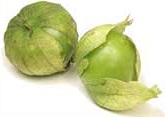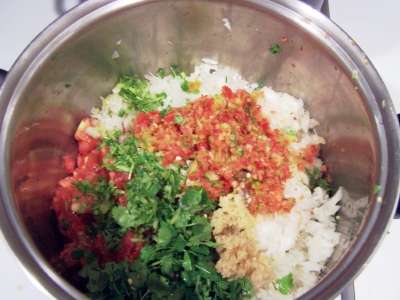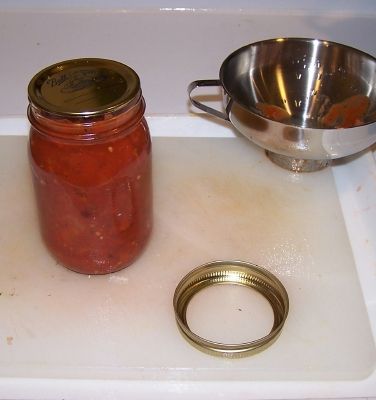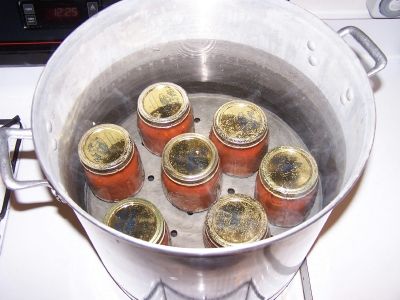
Looking for Making and Canning Homemade Tomatillo Salsa from Fresh Tomatillos in 2025? Scroll down this page and follow the links. And if you bring home some fruit or vegetables and want to can, freeze, make jam, salsa or pickles, see this page for simple, reliable, illustrated canning, freezing or preserving directions. There are plenty of other related resources, click on the resources dropdown above. If you are having a hard time finding canning lids, I've used these, and they're a great price & ship in 2 days.
If you have questions or feedback, please let me know! There are affiliate links on this page. Read our disclosure policy to learn more.
Making and Canning Homemade Tomatillo Salsa from Fresh Tomatillos
Making and Canning Homemade Tomatillo Salsa
Yield: about 2 pints (or 4 eight ounce jars)
- Tomatillos -5 cups of husked, cored, chopped, tomatillos. This makes about 2 pints of salsa! You can double, triple, etc, this recipe to make more.
- Green chiles - 1-1/2 cups seeded, chopped green chile peppers
- Jalapeno peppers - 1/2 cup seeded, finely chopped jalapeno peppers
- 4 cups chopped onions (the Ball Blue Book recipe uses only 1 cup, so you may reduce the amount of onions, if you prefer,)
- 1 cup bottled lemon or lime juice (The Ball Blue Book recipe uses a mix of vinegar and lime juice; if you prefer the vinegar taste, you may mix it instead)
- 6 cloves garlic, finely chopped or pureed.
- 1 tablespoon ground cumin (optional)
- 3 tablespoons dried oregano leaves (optional)
- 2 tablespoons of minced (finely diced) cilantro
- 1 tablespoon salt (optional)
- 1 teaspoon black pepper
Equipment
- 1 water bath canner (a huge pot to sanitize the jars after filling (about $30 to $35 - $30 at mall kitchen stores and local "big box" stores. Note: we sell canners, supplies and kits through our affiliates: click here or see the bottom of this page) Tomatillos are on the border between the high-acid fruits that can be preserved in a boiling-water bath and the low-acid fruits, vegetables and meats that need pressure canning.
- Pint (or smaller) canning jars (Ball or Kerr jars can be found at Publix, Kroger, Safeway and local "big box" stores - about $13 per dozen 8-ounce jars, more for quilted design or larger jars, including the lids and rings).
- Lids - thin, flat, round metal lids with a gum binder that seals them against the top of the jar. They may only be used once.
- Rings - metal bands that secure the lids to the jars. They may be reused many times.
- Jar grabber (to pick up the hot jars)
- Lid lifter (I like the lid rack that holds 12 lids or you can pull them out one at a time with the lid-lifter that has a magnet from the almost-boiling water where you sanitize them. ($4 at mall kitchen stores and local "big box" stores, but it's usually cheaper online from our affiliates)
- 1 large pot.
- Large spoons and ladles,
- Jar funnel ($3-Grocery stores, like Publix, Kroger and Safeway and local "big box" stores; sometimes even hardware stores)
 Process - How to Make Salsa from Fresh Tomatillos
Process - How to Make Salsa from Fresh Tomatillos
Step 1 - Selecting the tomatillos
It's fun to grow your own or go pick your own; you can obviously get better quality tomatillos!
 Step
2 - Get the jars and lids sanitizing
Step
2 - Get the jars and lids sanitizing
The dishwasher is fine for the jars; especially if it has a "sanitize" cycle. I get that going while I'm preparing everything else, so it's done by the time I'm ready to fill the jars.
Be sure to let it go through the rinse cycle to get rid of any soap!
Lids: Put the very hot (but not quite boiling; around 180 F, steaming water is fine)
water for at least
several minutes.
Note: everything gets sanitized in the water bath (step 7) anyway, so this just helps to ensure there is no spoilage later!)
Step 3 - Husk, Wash, Core and Chop the Tomatillos
Remove the dry outer husks from tomatillos, then wash the tomatillos in cool water thoroughly. They do not need to be peeled or seeded. Next just chop them into small cubes, about 1/2 inch across.
Step 4. Prepare the peppers
The skin of green chiles can be tough; but they may be removed by heating the peppers. Usually when peppers are finely chopped, they do not need to be skinned. Obviously, most people prefer to just chop the chilies.
However, if you choose to peel chiles, slit each pepper along the side to allow steam to escape. Peel using one of these two methods:
- Oven or broiler method to blister skins - Place chiles in a hot oven (400°F) or broiler for 6 to 8 minutes until skins blister.
- Range-top method to blister skins - Cover hot burner (either gas or electric) with heavy wire mesh. Place peppers on burner for several minutes until skins blister.
To peel, after blistering skins, place peppers in a pan and cover with a damp cloth. (This will make peeling the peppers easier.) Cool several minutes; slip off skins. Discard seeds and chop.
The jalapeno peppers do not need to be peeled, but seeds are often removed; just scrape them out with your finger under running water.
Step 5 - Mix all of the ingredients in the pot and bring the sauce to a gentle simmer
Combine all of the ingredients in the pot, and stir frequen tly over high
heat until mixture begins to boil, then reduce heat and simmer for 2O
minutes, stirring occasionally.
tly over high
heat until mixture begins to boil, then reduce heat and simmer for 2O
minutes, stirring occasionally.
S tep
6 - Fill the jars with sauces and put the lid and rings on
tep
6 - Fill the jars with sauces and put the lid and rings on
Fill them to within 1/2-inch of the top, seat the lid and hand-tighten the ring around them. Keep moving so the contents don't cool down!
Be sure the contact surfaces (top of the jar and underside of the ring) are clean to get a good seal!
Step 7 - Boil the jars in the canner
Put them in the canner and keep them covered with at least 1 to 2 inches of water. Keep the water boiling. Process the jars in a boiling-water bath for:
| Recommended process time for Tomatillo Salsa in a boiling-water canner. | ||||
| Process Time at Altitudes of | ||||
| Style of Pack | Jar Size | 0 - 1,000 ft | 1,001 - 6,000 ft | Above 6,000 ft |
| Hot | Pints or 8 oz jars | 15 min | 20 | 25 |
IMPORTANT:
The USDA says the only change you can safely make in this salsa recipe
is to change the amount of spices and herbs. Do not alter the
proportions of vegetables to acid and tomatillos because it might make the
salsa unsafe. Do not substitute vinegar for the lemon juice.
I prefer a Pressure Canner or a taller water bath canner, shown at right - To order one, see the bottom of this page or Canning supplies!
Step 8 - Done
Lift the jars out of the water and let them cool without touching or bumping them in a draft-free place (usually takes overnight) You can then remove the rings if you like, but if you leave them on, at least loosen them quite a bit, so they don't rust in place due to trapped moisture. Once the jars are cool, you can check that they are sealed verifying that the lid has been sucked down. Just press in the center, gently, with your finger. If it pops up and down (often making a popping sound), it is not sealed. If you put the jar in the refrigerator right away, you can still use it. Some people replace the lid and reprocess the jar, then that's a bit iffy. If you heat the contents back up, re-jar them (with a new lid) and the full time in the canner, it's usually ok.
Adapted from the USDA/UGa National Center for Home Food Preservation's recipe and Ball Blue Book recipe.
USDA says the Nutrition Information is:
(Estimated values using Nutritionist Pro™ software)
Per 2 Tbsp:
Calories 10, Total Fat 0 g, Sodium 89 mg, Fiber 0 g, Protein 0 g.
Daily
Values: Vitamin A 1%, Vitamin C 17%, Calcium 1%, Iron 1%.
Percent Daily
Values based on Dietary Reference Intakes.
Other Equipment:From left to right:
|
 |
Answers to Common Questions
What did I do wrong if my jars spoil?
Tomatillos are a borderline acid / low acid fruit (see this page about tomato acidity for more information) - adding lemon juice helps, processing according to the specified times (determined by the USDA) in the water bath canner, or better still, using a Pressure Canner almost eliminates spoilage. If you don't have a Pressure Canner, you must boost the acid level of the sauce, by adding 2 tablespoons of lemon juice or 1/2 teaspoon of citric acid per quart of sauce. (or half that, for pint jars)
Probably not. According to the USDA's National Center for Home Food Preservation:
"Salsas are usually mixtures of acid and low-acid ingredients; they are an example of an acidified food. The specific recipe, and sometimes preparation method, will determine if a salsa can be processed in a boiling water canner or a Pressure Canner. A process must be scientifically determined for each recipe. "
The USDA does accept that if you take an approved, tested recipe and make minor alterations to ingredients that does affect the preserving properties, that should be ok. But there are a lot of if's in that statement. For example, substituting 1 teaspoon of ground chili spice for 1/2 teaspoon of ground black pepper is probably fine, but substituting 1 cup of apple juice for 1 cup of lemon juice would not be. Unless you really know what you're doing, you should probably stick to the approved recipes. The preserving recipes I publish, like the one above, are all from the USDA, universities or established canning authorities. Granny probably never did lab cultures and bacteria counts to test that her recipe was safe; you were her test guinea pig, and that's not as reliable as a culture (next time you might get sick)
Here are some Salsa Guidelines from Penn State University:
- Do not substitute vinegar for lemon juice, but you can substitute lemon juice for vinegar. Lemon juice is more acidic.
- Do not reduce the amount of lemon juice or tomatillos.
- Do not add extra peppers, onions, or garlic. You can reduce the amount of peppers, onions, or garlic.
- Canned chilies may be used in place of fresh.
- You can substitute one type of pepper for another. For example, hot jalapeno peppers, bell peppers, yellow peppers, banana peppers, chili peppers and cubinal peppers may all be substituted 1 for 1.
- The key is not increasing the amount of low acid ingredients in relation to the amount of high acid ingredients
My question is about salsa. I was going to borrow a water bath canner,to
make salsa this year (for the first time). My grandma told me that I didn't need
the water bath canner, I could just make salsa using the "inversion" method like I
did the blueberry jam. Can I do this?
Well, Grandma may be sweet, but a lot of her generation died of cancer from
smoking, heart attacks from eating too much saturated fat... And food poisoning!
:) Jam should get 5 minutes in the boiling water bath, too.
Tomatillos have enough acid to require only a water bath for processing; but by
the time you add the other ingredients which have no acidity, you've got a food
that can spoil easily. That's why most salsa recipes include a couple of cups of
vinegar or lemon juice (both very acidic).
Even so, a Pressure Canner affords greater safety that a boiling water bath, and
is more versatile. But if you follow my recipe and use vinegar or lemon juice as
stated in the recipe, the boiling water bath will work fine.
And let Grandma make the cookies rather than the preserves! :)
Comments and feedback
Comments from a visitor on September 15, 2011: "I made your salsa recipe last
night and we LOVED it! I look forward to canning some for the winter! Thank you
for sharing! (I never removed tomato seeds/water when I make spaghetti sauce
until reading your site. It cut my cooking time and I can't wait to taste the
new, thicker sauce!) "
Looking for canning equipment and supplies?
Water bath canner with a jar rack
Pressure canners for gas, electric and induction stoves: Presto 23Qt or T-fal 22Qt
Canning scoop (this one is PERFECT)
Ball Blue book (most recent version)
Jars: 8oz canning jars for jams
Find Other types of farms:
Farm markets and roadside stands
Road trips and camping resources
Local Honey, apiaries, beekeepers
Consumer fraud and scams information
Home canning supplies at the best prices on the internet!
Maple Syrup Farms, sugarworks, maple syrup festivals
Environmental information and resources
Farms For Your Event for birthday parties, weddings, receptions, business meetings, retreats, etc.
Festivals - local fruit and vegetable festivals
Get the
most recent version of
the Ball Blue Book
With this Presto 23 quart pressure canner and pressure cooker, you can "can" everything, fruits, vegetables, jams, jellies, salsa, applesauce, pickles, even meats, soups, stews. Model 01781

You can make jams, jellies, can fruit, applesauce, salsa and pickles with water bath canners, like this Granite Ware 12-Piece Canner Kit, Jar Rack, Blancher, Colander and 5 piece Canning Tool Set

